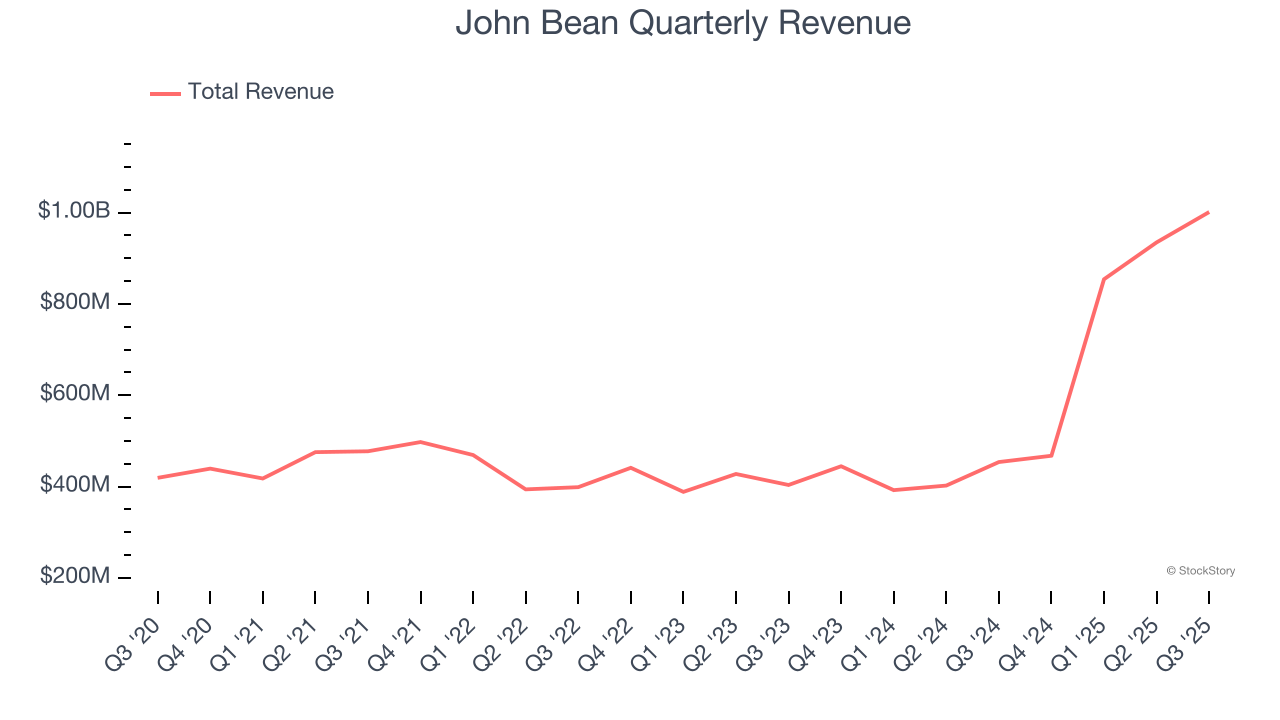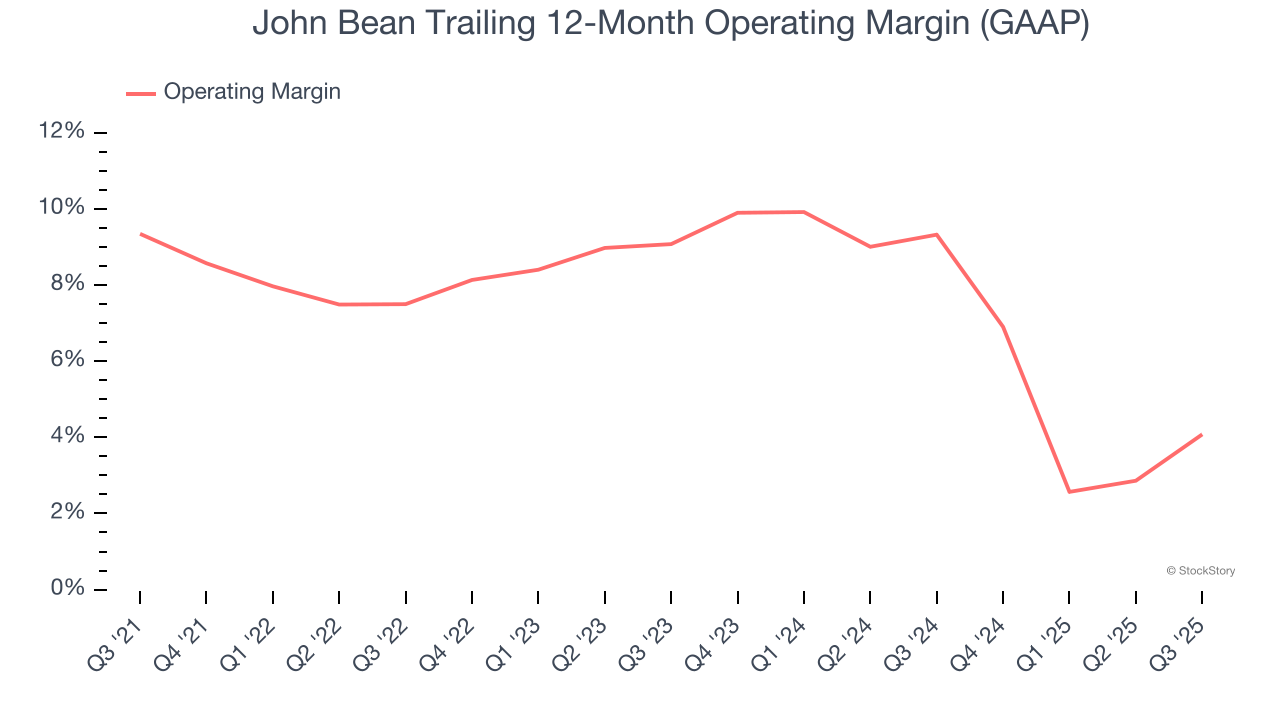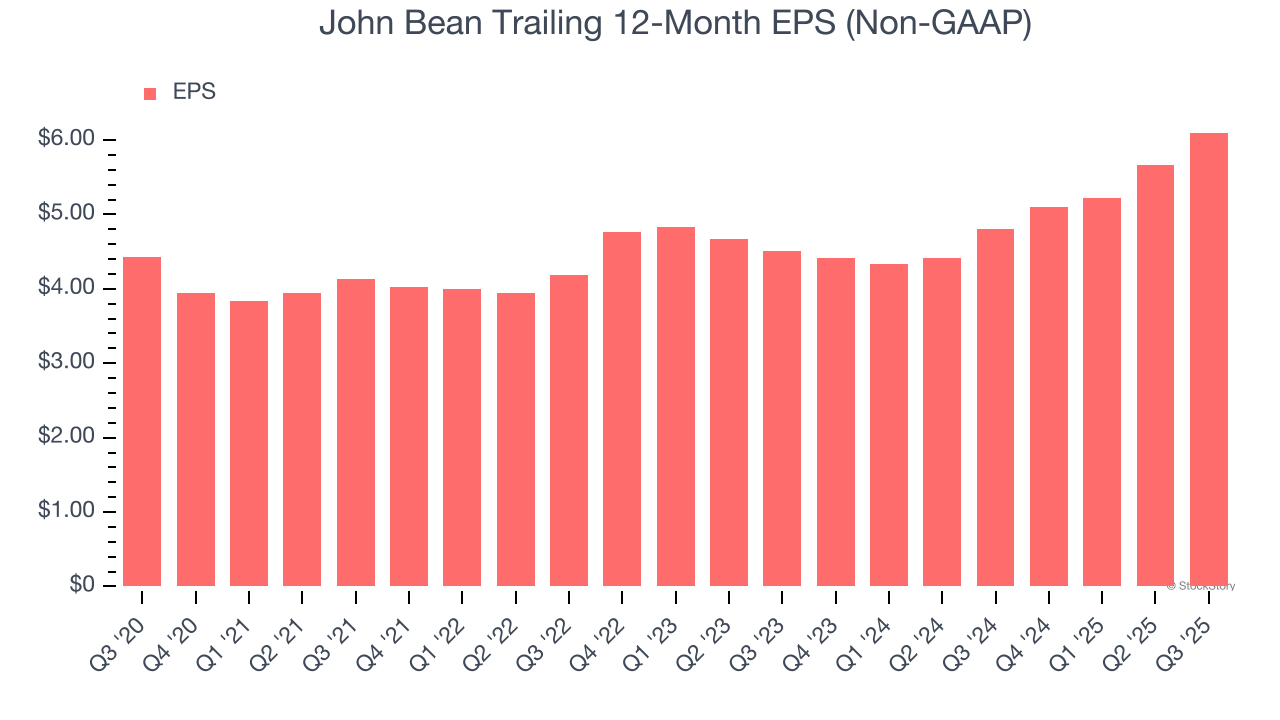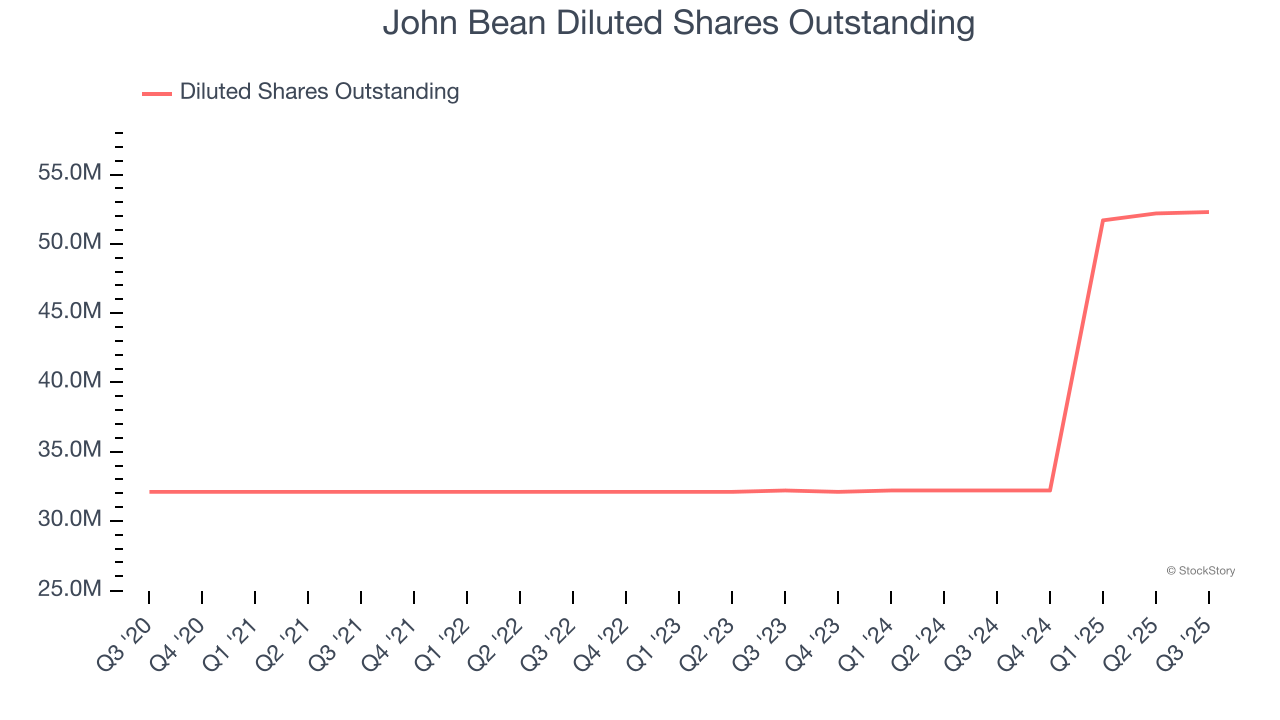
Food processing and aviation equipment manufacturer John Bean (NYSE: JBT) reported Q3 CY2025 results beating Wall Street’s revenue expectations, with sales up 121% year on year to $1.00 billion. The company’s full-year revenue guidance of $3.78 billion at the midpoint came in 1.9% above analysts’ estimates. Its non-GAAP profit of $1.94 per share was 28.9% above analysts’ consensus estimates.
Is now the time to buy John Bean? Find out by accessing our full research report, it’s free for active Edge members.
John Bean (JBTM) Q3 CY2025 Highlights:
- Revenue: $1.00 billion vs analyst estimates of $934 million (121% year-on-year growth due to the Marel acquisition that closed earlier this year, 7.2% beat)
- Adjusted EPS: $1.94 vs analyst estimates of $1.51 (28.9% beat)
- Adjusted EBITDA: $170.9 million vs analyst estimates of $146.3 million (17.1% margin, 16.8% beat)
- The company lifted its revenue guidance for the full year to $3.78 billion at the midpoint from $3.7 billion, a 2% increase
- Management raised its full-year Adjusted EPS guidance to $6.25 at the midpoint, a 7.8% increase
- EBITDA guidance for the full year is $597.5 million at the midpoint, above analyst estimates of $588 million
- Operating Margin: 10.2%, in line with the same quarter last year
- Free Cash Flow Margin: 5.6%, down from 14.5% in the same quarter last year
- Market Capitalization: $6.55 billion
"JBT Marel outperformed our third quarter earnings expectations, primarily driven by better-than-expected revenue, excellent supply chain and operational productivity, and solid cost control," said Brian Deck, Chief Executive Officer.
Company Overview
Tracing back to its invention of the mechanical milk bottle filler in 1884, John Bean (NYSE: JBT) designs, manufactures, and sells equipment used for food processing and aviation.
Revenue Growth
Reviewing a company’s long-term sales performance reveals insights into its quality. Any business can put up a good quarter or two, but the best consistently grow over the long haul. Over the last five years, John Bean grew its sales at an excellent 12.2% compounded annual growth rate. Its growth beat the average industrials company and shows its offerings resonate with customers.

We at StockStory place the most emphasis on long-term growth, but within industrials, a half-decade historical view may miss cycles, industry trends, or a company capitalizing on catalysts such as a new contract win or a successful product line. John Bean’s annualized revenue growth of 40% over the last two years is above its five-year trend, suggesting its demand was strong and recently accelerated.

This quarter, John Bean reported magnificent year-on-year revenue growth of 121% due to the Marel acquisition that closed earlier this year, and its $1.00 billion of revenue beat Wall Street’s estimates by 7.2%.
Looking ahead, sell-side analysts expect revenue to grow 17.9% over the next 12 months, a deceleration versus the last two years. Despite the slowdown, this projection is noteworthy and suggests the market is baking in success for its products and services.
The 1999 book Gorilla Game predicted Microsoft and Apple would dominate tech before it happened. Its thesis? Identify the platform winners early. Today, enterprise software companies embedding generative AI are becoming the new gorillas. a profitable, fast-growing enterprise software stock that is already riding the automation wave and looking to catch the generative AI next.
Operating Margin
Operating margin is an important measure of profitability as it shows the portion of revenue left after accounting for all core expenses – everything from the cost of goods sold to advertising and wages. It’s also useful for comparing profitability across companies with different levels of debt and tax rates because it excludes interest and taxes.
John Bean was profitable over the last five years but held back by its large cost base. Its average operating margin of 7.3% was weak for an industrials business. This result is surprising given its high gross margin as a starting point.
Looking at the trend in its profitability, John Bean’s operating margin decreased by 5.3 percentage points over the last five years. This raises questions about the company’s expense base because its revenue growth should have given it leverage on its fixed costs, resulting in better economies of scale and profitability. John Bean’s performance was poor no matter how you look at it - it shows that costs were rising and it couldn’t pass them onto its customers.

This quarter, John Bean generated an operating margin profit margin of 10.2%, in line with the same quarter last year. This indicates the company’s cost structure has recently been stable.
Earnings Per Share
We track the long-term change in earnings per share (EPS) for the same reason as long-term revenue growth. Compared to revenue, however, EPS highlights whether a company’s growth is profitable.
John Bean’s EPS grew at an unimpressive 6.6% compounded annual growth rate over the last five years, lower than its 12.2% annualized revenue growth. However, its operating margin actually improved during this time, telling us that non-fundamental factors such as interest expenses and taxes affected its ultimate earnings.

We can take a deeper look into John Bean’s earnings to better understand the drivers of its performance. As we mentioned earlier, John Bean’s operating margin was flat this quarter but declined by 5.3 percentage points over the last five years. Its share count also grew by 62.9%, meaning the company not only became less efficient with its operating expenses but also diluted its shareholders. 
Like with revenue, we analyze EPS over a more recent period because it can provide insight into an emerging theme or development for the business.
For John Bean, its two-year annual EPS growth of 16.3% was higher than its five-year trend. This acceleration made it one of the faster-growing industrials companies in recent history.
In Q3, John Bean reported adjusted EPS of $1.94, up from $1.50 in the same quarter last year. This print easily cleared analysts’ estimates, and shareholders should be content with the results. Over the next 12 months, Wall Street expects John Bean’s full-year EPS of $6.10 to grow 17.2%.
Key Takeaways from John Bean’s Q3 Results
It was good to see John Bean beat analysts’ EPS expectations this quarter. We were also excited its EBITDA outperformed Wall Street’s estimates by a wide margin. Zooming out, we think this was a solid print. The stock remained flat at $124.62 immediately after reporting.
Should you buy the stock or not? The latest quarter does matter, but not nearly as much as longer-term fundamentals and valuation, when deciding if the stock is a buy. We cover that in our actionable full research report which you can read here, it’s free for active Edge members.





